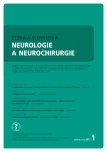Current Perception of Contraindications and Complications of Nerve Conduction Studies and Needle Electromyography
Authors:
E. Vlčková; J. Bednařík
Authors‘ workplace:
Neurologická klinika LF MU a FN Brno
Published in:
Cesk Slov Neurol N 2017; 80/113(1): 43-48
Category:
Review Article
Overview
Clinical electromyography (EMG) is a key diagnostic tool in many neuromuscular diseases. Despite this, many laboratories do not perform nerve conduction studies (NCS) in patients with a pacemaker or implantable cardioverter-defibrillator. Furthermore, some labs do not perform needle EMG or at least do not examine some of the higher risk muscle groups in patients on anticoagulant or even antiplatelet therapy. In rare cases, EMG examination may also be complicated by leakage, transmission of infectious diseases, pneumothorax, compartment syndrome, or a peripheral nerve lesion. The aim of this study was to summarize current knowledge and recommendations related to these limitations and complications of EMG examination. According to published studies, common as well as repetitive electrical peripheral nerve stimulation can be performed in patients with pacemaker/defibrillator. Stimulation in close proximity to pacemaker/defibrillator should be avoided to prevent electromagnetic interference with their function. No increased systemic risk of clinically significant intramuscular haemorrhage was found in patients on an anticoagulant or antiplatelet therapy. Intramuscular hematomas resulting from needle EMG are usually very small (several millimetres) and clinically asymptomatic. Symptomatic and asymptomatic haemorrhages following needle EMG can occur without any relation to anticoagulant/ antiplatelet therapy. However, they are generally rare and needle EMG is considered to be a safe diagnostic tool. In patients taking anticoagulation medication, thrombotic risk of discontinuing anticoagulation prior to EMG outweighs the risks associated with needle examination while on anticoagulation. All other EMG complications listed above are very rare but relevant. Therefore, it should always be carefully considered whether EMG examination is indicated. General technical and hygienic-epidemiological recommendations for EMG examination should be strictly followed to minimise the incidence of complications.
Key words:
electromyography – artificial pacemaker – implantable defibrillators – electric stimulation – warfarin – anticoagulant agents – antiplatelet agents – haemorrhage – infection – pneumothorax
The authors declare they have no potential conflicts of interest concerning drugs, products, or services used in the study.
The Editorial Board declares that the manuscript met the ICMJE “uniform requirements” for biomedical papers.
Sources
1. Guidelines in electrodiagnostic medicine. Risks in electrodiagnostic medicine. American Association of Electrodiagnostic Medicine. Muscle Nerve 1999;8(Suppl 1):S53– 69.
2. American Association of Electrodiagnostic Medicine.Risks in electrodiagnostic medicine. Rochester, MN: AAEM; 2009. [accesed 2016 May 10]. Available from URL: http://www.aanem.org/AANEM/media/AANEM/Documents/Practice/Position%20Statements/risksinEDX.pdf.
3. Gruis KL, Little AA, Zebarah VA, et al. Survey of electrodiagnostic laboratories regarding hemorrhagic complications from needle electromyography. Muscle Nerve 2006;34(3):356– 8.
4. Schoeck AP, Mellion ML, Gilchrist JM, et al. Safety of nerve conduction studies in patients with implanted cardiac devices. Muscle Nerve 2007;35(4):521– 4.
5. Mellion ML, Buxton AE, Iyer V, et al. Safety of nerve conduction studies in patients with peripheral intravenous lines. Muscle Nerve 2010;42(2):189– 91. doi: 10.1002/ mus.21714.
6. Cronin EM, Gray J, Abi-Saleh B, et al. Safety of repetitive nerve stimulation in patients with cardiac implantable electronic devices. Muscle Nerve 2013;47(6):840– 4. doi: 10.1002/mus.23707.
7. Engelhardt L, Grosse J, Birnbaum J, et al. Inhibition of a pacemaker during nerve stimulation for regional anaesthesia. Anaesthesia 2007;62(10):1071– 4.
8. Al-Shekhlee A, Shapiro BE, Preston DC. Iatrogenic complications and risks of nerve conduction studies and needle electromyography. Muscle Nerve 2003;27(5):517– 26.
9. Kadaňka Z, Bednařík J, Voháňka S. Praktická elektromyografie. 1. vyd. Brno: IDPVZ 1994.
10. Wysowski DK, Nourjah P, Swartz L. Bleeding complications with warfarin use: a prevalent adverse effect resulting in regulatory action Arch Intern Med 2007;167(13):1414– 9.
11. Butler ML, Dewan RW. Subcutaneous hemorrhage in a patient receiving anticoagulant therapy: an unusual EMG complication. Arch Phys Medi Rehabil 1984;65(11):733– 4.
12. Rosioreanu A, Dickson A, Lypen S, et al. Pseudoaneurysm of the calf after electromyography: sonographic and CT angiographic diagnosis. AJR Am J Roentgenol 2005;185(1):282– 3.
13. Caress JB, Rutkove SB, Carlin M, et al. Paraspinal muscle hematoma after electromyography. Neurology 1996;47(1):269– 72.
14. Farrell CM, Rubin DI, Haidukewych GJ. Acute compartment syndrome of the leg following diagnostic electromyography. Muscle Nerve 2003;27(3):374– 7.
15. Vaienti L, Vourtsis S, Urzola V. Compartment syndrome of the forearm following an electromyographic assessment. J Hand Surg Br 2005;30(6):656– 7.
16. Brewer MB, Folstein MK, Kerns M, et al. Compartment syndrome of the thigh as a complication of electromyography. Am Surg 2012;78(2):72– 3.
17. Gertken JT, Hunt CH, Montes Chinea NI, et al. Risk of hematoma following needle electromyography of the paraspinal muscles. Muscle Nerve 2011;44(3):439– 40. doi: 10.1002/ mus.22138.
18. London Z, Quint DJ, Haig AJ, et al. The risk of hematoma following extensive electromyography of the lumbar paraspinal muscles. Muscle Nerve 2012;46(1):26– 30. doi: 10.1002/ mus.23288.
19. Gertken JT, Patel AT, Boon AJ. Electromyography and anticoagulation. PM R 2013;5(Suppl):S3– 7. doi: 10.1016/ j.pmrj.2013.03.018.
20. Lynch SL, Boon AJ, Smith J, et al. Complications of needle electromyography: hematoma risk and correlation with anticoagulation and antiplatelet therapy. Muscle Nerve 2008;38(4):1225– 30. doi: 10.1002/ mus.21111.
21. Boon AJ, Gertken JT, Watson JC, et al. Hematoma risk after needle electromyography. Muscle Nerve 2012;45(1):9– 12. doi: 10.1002/ mus.22227.
22. Caress JB. Bleeding and electromyography: the needle and the damage (not) done. Muscle Nerve 2011;44(3):313– 5. doi: 10.1002/ mus.22137.
23. Kassardjian CD, O‘Gorman CM, Sorenson EJ. The risk of iatrogenic pneumothorax after electromyography. Muscle Nerve 2016;53(4):518– 21. doi: 10.1002/ mus.24883.
24. Unlüer EE, Akyol PY, Karagöz A, et al. A deadly complication of superficial muscular needle electromyography: bilateral pneumothoraces. Case Rep Med 2013;2013:861787. doi: 10.1155/ 2013/ 861787.
Labels
Paediatric neurology Neurosurgery NeurologyArticle was published in
Czech and Slovak Neurology and Neurosurgery

2017 Issue 1
Most read in this issue
- Current Perception of Contraindications and Complications of Nerve Conduction Studies and Needle Electromyography
- Essential Neurological Examination – Time for Change?
- Extirpation of Colloid Cyst by an Endoscopic Approach
- Periodic Limb Movements During Sleep are More Severe in Narcolepsy with Cataplexy than in Narcolepsy without Cataplexy
